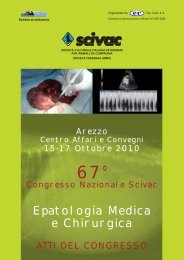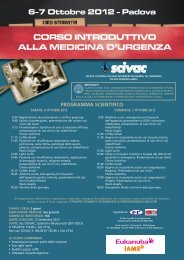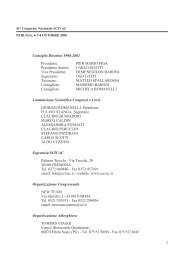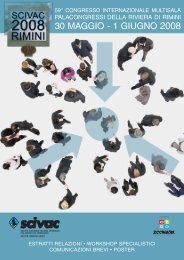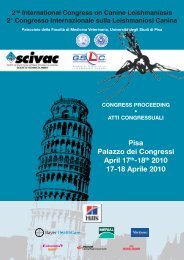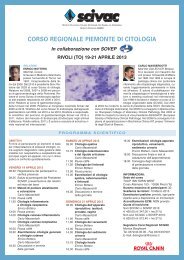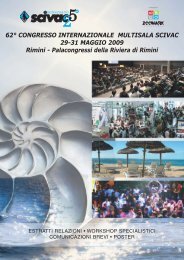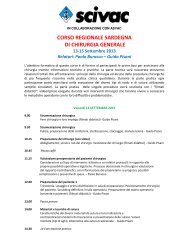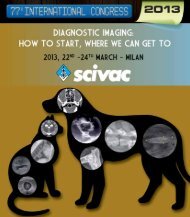58° Congresso Nazionale SCIVAC: Oncologia veterinaria
58° Congresso Nazionale SCIVAC: Oncologia veterinaria
58° Congresso Nazionale SCIVAC: Oncologia veterinaria
Create successful ePaper yourself
Turn your PDF publications into a flip-book with our unique Google optimized e-Paper software.
58° <strong>Congresso</strong> <strong>Nazionale</strong> <strong>SCIVAC</strong> • Milano, 7-9 Marzo 2008 • <strong>Oncologia</strong> <strong>veterinaria</strong> - Alle soglie del III Millennio<br />
protocol was used at UC Davis and 82 dogs were treated. 64% attained complete<br />
responses, with median relapse-free survival for those with complete remission<br />
being 217 days. Median overall survival durations for dogs with complete<br />
response was 366 days, with 26% 2 year survival reported for the UC Davis<br />
dogs. Disadvantages of this protocol include the fact that it is complicated<br />
in terms of scheduling and has the potential for the side effects described above<br />
for the combination drugs and Adriamycin alone. Side effects of varying severity<br />
can be seen in over 60% of patients treated with this protocol. The cost<br />
of this therapy is considerable, because of the expense of the drugs and monitoring<br />
for toxicity over the 2 year potential treatment period.<br />
ACOPA protocols<br />
Other combination chemotherapy include those used at Tufts University<br />
(ACOPA I and II protocols) and a short-term (12 weeks) fractionated combination.<br />
The Tufts protocols involved combinations of COP plus L-asparaginase<br />
(Elspar) and doxorubicin using different schedules. In the earlier ACO-<br />
PA I protocol reported by Stone et al in 1991, 76% of 41 dogs attained a complete<br />
remission, median remission duration 11 months and with 48% being in<br />
remission at one year. ACOPA I used vincristine, L-asparaginase and prednisone<br />
for induction and cyclophosphamide and doxorubicin for maintenance.<br />
ACOPA II was reported in 1997 and consisted of doxorubicin and prednisone<br />
induction with doxorubicin, vincristine, cyclophosphamide, prednisone<br />
and pulsed L-asparaginase maintenance therapy. ACOPA II was studied in 68<br />
dogs, of which 65% attained complete remission with a median remission duration<br />
in this subset of dogs of 9 months and 40% in remission at one year and<br />
21% at two years. Interestingly, 37% of patients on the ACOPA I trial required<br />
modifications in dose or scheduling of chemotherapy because of toxicity,<br />
as compared with 62% of patients on ACOPA II. Thus on the surface it would<br />
appear that the ACOPA I protocol was superior (higher remission rates, longer<br />
remission duration, and lower dose-limiting toxicities). However more patients<br />
with advanced (Stage V) disease were entered into the ACOPA II arm,<br />
and a substantial number were lost to follow up while in complete remission.<br />
These factors may have biased results against this protocol.<br />
COPLA protocol<br />
At Michigan State University, we are using an independently developed but<br />
similar version of combination chemotherapy for canine lymphoma. (See attached<br />
protocol). Currently, median survival times with this protocol, plus rescue<br />
84



